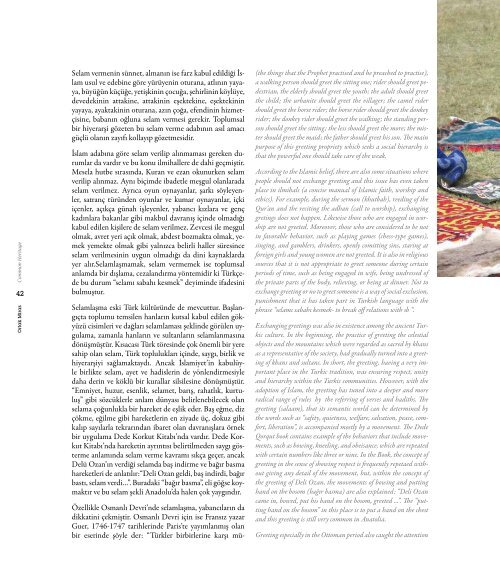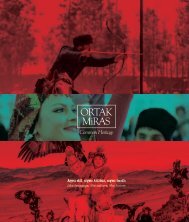Create successful ePaper yourself
Turn your PDF publications into a flip-book with our unique Google optimized e-Paper software.
Common Heritage<br />
42<br />
Ortak Miras<br />
Selam vermenin sünnet, almanın ise farz kabul edildiği İslam<br />
usul ve edebine göre yürüyenin oturana, atlının yayaya,<br />
büyüğün küçüğe, yetişkinin çocuğa, şehirlinin köylüye,<br />
devedekinin attakine, attakinin eşektekine, eşektekinin<br />
yayaya, ayaktakinin oturana, azın çoğa, efendinin hizmetçisine,<br />
babanın oğluna selam vermesi gerekir. Toplumsal<br />
bir hiyerarşi gözeten bu selam verme adabının asıl amacı<br />
güçlü olanın zayıfı kollayıp gözetmesidir.<br />
İslam adabına göre selam verilip alınmaması gereken durumlar<br />
da vardır ve bu konu ilmihallere de dahi geçmiştir.<br />
Mesela hutbe sırasında, Kuran ve ezan okunurken selam<br />
verilip alınmaz. Aynı biçimde ibadetle meşgul olanlarada<br />
selam verilmez. Ayrıca oyun oynayanlar, şarkı söyleyenler,<br />
satranç türünden oyunlar ve kumar oynayanlar, içki<br />
içenler, açıkça günah işleyenler, yabancı kızlara ve genç<br />
kadınlara bakanlar gibi makbul davranış içinde olmadığı<br />
kabul edilen kişilere de selam verilmez. Zevcesi ile meşgul<br />
olmak, avret yeri açık olmak, abdest bozmakta olmak, yemek<br />
yemekte olmak gibi yalnızca belirli haller süresince<br />
selam verilmesinin uygun olmadığı da dini kaynaklarda<br />
yer alır.Selamlaşmamak, selam vermemek ise toplumsal<br />
anlamda bir dışlama, cezalandırma yöntemidir ki Türkçede<br />
bu durum “selamı sabahı kesmek” deyiminde ifadesini<br />
bulmuştur.<br />
Selamlaşma eski Türk kültüründe de mevcuttur. Başlangıçta<br />
toplumu temsilen hanların kutsal kabul edilen gökyüzü<br />
cisimleri ve dağları selamlaması şeklinde görülen uygulama,<br />
zamanla hanların ve sultanların selamlanmasına<br />
dönüşmüştür. Kısacası Türk töresinde çok önemli bir yere<br />
sahip olan selam, Türk toplulukları içinde, saygı, birlik ve<br />
hiyerarşiyi sağlamaktaydı. Ancak İslamiyet’in kabulüyle<br />
birlikte selam, ayet ve hadislerin de yönlendirmesiyle<br />
daha derin ve köklü bir kurallar silsilesine dönüşmüştür.<br />
“Emniyet, huzur, esenlik, selamet, barış, rahatlık, kurtuluş”<br />
gibi sözcüklerle anlam dünyası belirlenebilecek olan<br />
selama çoğunlukla bir hareket de eşlik eder. Baş eğme, diz<br />
çökme, eğilme gibi hareketlerin en ziyade üç, dokuz gibi<br />
kalıp sayılarla tekrarından ibaret olan davranışlara örnek<br />
bir uygulama Dede Korkut Kitabı’nda vardır. Dede Korkut<br />
Kitabı’nda hareketin ayrıntısı belirtilmeden saygı gösterme<br />
anlamında selam verme kavramı sıkça geçer, ancak<br />
Delü Ozan’ın verdiği selamda baş indirme ve bağır basma<br />
hareketleri de anlatılır:“Deli Ozan geldi, baş indirdi, bağır<br />
bastı, selam verdi…”. Buradaki “bağır basma”, eli göğse koymaktır<br />
ve bu selam şekli Anadolu’da halen çok yaygındır.<br />
Özellikle Osmanlı Devri’nde selamlaşma, yabancıların da<br />
dikkatini çekmiştir. Osmanlı Devri için ise Fransız yazar<br />
Guer, 1746-1747 tarihlerinde Paris’te yayımlanmış olan<br />
bir eserinde şöyle der: “Türkler birbirlerine karşı mü-<br />
(the things that the Prophet practised and he preached to practise),<br />
a walking person should greet the sitting one; rider should greet pedestrian,<br />
the elderly should greet the youth; the adult should greet<br />
the child; the urbanite should greet the villager; the camel rider<br />
should greet the horse rider; the horse rider should greet the donkey<br />
rider; the donkey rider should greet the walking; the standing person<br />
should greet the sitting; the less should greet the more; the mister<br />
should greet the maid; the father should greet his son. The main<br />
purpose of this greeting propriety which seeks a social hierarchy is<br />
that the powerful one should take care of the weak.<br />
According to the Islamic belief, there are also some situations where<br />
people should not exchange greeting and this issue has even taken<br />
place in ilmihals (a concise manual of Islamic faith, worship and<br />
ethics). For example, during the sermon (khutbah), reeding of the<br />
Qur’an and the reciting the adhan (call to worship), exchanging<br />
gretings does not happen. Likewise those who are engaged in worship<br />
are not greeted. Moreover, those who are considered to be not<br />
in favorable behavior, such as playing games (chess-type games),<br />
singing, and gamblers, drinkers, openly comitting sins, staring at<br />
foreign girls and young women are not greeted. It is also in religious<br />
sources that it is not appropriate to greet someone during certain<br />
periods of time, such as being engaged in wife, being undressed of<br />
the private parts of the body, relieving, or being at dinner. Not to<br />
exchange greeting or no to greet someone is a way of social exclusion,<br />
punishment that it has taken part in Turkish language with the<br />
phrase “selamı sabahı kesmek- to break off relations with sb “.<br />
Exchanging greetings was also in existence among the ancient Turkic<br />
culture. In the beginning, the practice of greeting the celestial<br />
objects and the mountains which were regarded as sacred by khans<br />
as a representative of the society, had gradually turned into a greeting<br />
of khans and sultans. In short, the greeting, having a very important<br />
place in the Turkic tradition, was ensuring respect, unity<br />
and hierarchy within the Turkic communities. However, with the<br />
adoption of Islam, the greeting has tuned into a deeper and more<br />
radical range of rules by the referring of verses and hadiths. The<br />
greeting (salaam), that its semantic world can be determined by<br />
the words such as “safety, quietness, welfare, salvation, peace, comfort,<br />
liberation”, is accompanied mostly by a movement. The Dede<br />
Qorqut book contains example of the behaviors that include movements,<br />
such as bowing, kneeling, and obeisance, which are repeated<br />
with certain numbers like three or nine. In the Book, the concept of<br />
greeting in the sense of showing respect is frequently repetaed without<br />
giving any detail of the movement, but, within the concept of<br />
the greeting of Deli Ozan, the movements of bowing and putting<br />
hand on the bosom (bağır basma) are also explained: “Deli Ozan<br />
came in, bowed, put his hand on the bosom, greeted ...”. The “putting<br />
hand on the bosom” in this place is to put a hand on the chest<br />
and this greeting is still very common in Anatolia.<br />
Greeting especially in the Ottoman period also caught the attention
















